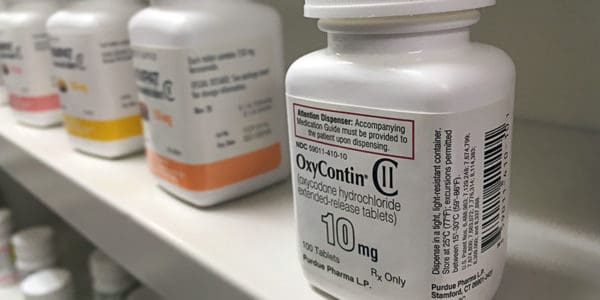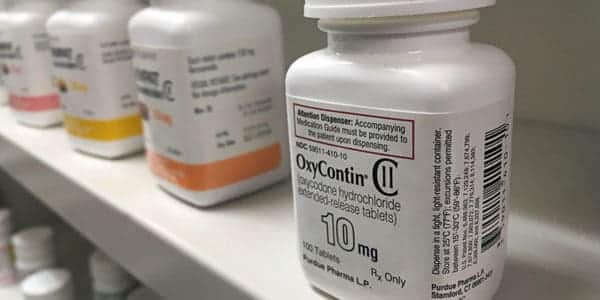After months of heated negotiations with attorney generals across the U.S., Purdue Pharma finally took the action it had been threatening as the basis for a nationwide settlement – they filed for Chapter 11 bankruptcy. Even before the opioid epidemic was officially recognized as a national crisis in the U.S., government lawyers looking for suitable culprits have been pointing a unanimous finger at one pharmaceutical company, and its owners, in particular – Purdue Pharma and the powerful, billionaire Sackler family. Purdue Pharma, of course, has been no stranger to the growing tide of outright blame (and legal pressure for massive sums of compensation) being directed straight at them. Back in 2007, when faced with both criminal and civil charges of “misbranding” their best-selling prescription drug OxyContin, Purdue accepted a plea agreement – they, their parent company, and three top executives were fined a total of $600 million. In a trend that has continued to this day, none of the executives named, who plead guilty, and were subsequently fined, had the surname Sackler. Just a few months after that 2007 plea agreement, Mortimer Sackler wrote an email to cousins which stated, “While things are looking better now, I would not count out the possibility that times will get much more difficult again in the future, and probably much sooner than we expect.” With retrospect, how right he was.
“Get your loved one the help they need. Our substance use disorder program accepts many health insurance plans, this is our residential program.”
Seeking what Purdue Pharma referred to as a “global settlement,” the pharmaceutical company and some, not all, of the U.S. attorney generals have finally reached an agreement regarding compensation. Many of the states represented in negotiations, basically, all of those that have filed lawsuits against Purdue Pharma and the Sackler family, have agreed to the current tentative agreement. However, the rest (a total of 24 states, in fact, plus the District of Columbia) remain unsatisfied that the billion-dollar figures mentioned, and the real extent of the family’s liability, do not nearly go far enough. 
What is the True Extent of the Opioid Crisis?
According to the National Institute on Drug Abuse, around 130 people in the U.S. are still dying every day from an opioid-related overdose. These fatal overdoses emanate from the misuse and abuse of prescription painkillers, with OxyContin being just one of these, heroin, and synthetic opioids, which are predominantly being illegally manufactured and often imported. The Centers for Disease Control and Prevention currently estimates that the “economic burden” endured nationwide of just the misuse of prescription opioids stands at around $78.5 billion a year in total. Here are just a few of the available, and deeply frightening, statistics about the extent of the crisis:
- 21 – 29% of patients prescribed opioids for chronic pain will misuse them.
- 8 – 12% will go on to develop an opioid use disorder.
- 4 – 6% who misuse such opioids will transition to heroin.
- Predominantly still, it is the young at the most vulnerable from opioid addiction; however, every U.S. demographic is suffering.
- The Midwestern region of the U.S. witnessed opioid overdose increases of a massive 70% from July 2016 to September 2017.
- In 2017, Idaho medical providers wrote 70.3 opioid prescriptions for every 100 persons Although this figure represents Idaho’s lowest prescribing rate in over 10 years, it is still higher than the national average of 58.7 opioid prescriptions.
How Did the Situation Reach Epidemic Status?
Today, opioid-based prescription painkillers now seem to be as common in our nation’s bathroom cabinets as the humble aspirin. Just that fact in itself is one of the main reasons we are in the midst of an opioid crisis, with many U.S. citizens in dire need of drug rehabilitation services. As we look to a future where these powerfully addictive drugs have far stricter controls, they will undoubtedly still be as permanent a fixture in chronic pain management as they are now. But where exactly did it all begin? How did we actually get to this point?
The History of Oxycodone
It all starts with OxyContin’s active ingredient – oxycodone. Oxycodone was developed in Germany back in 1916 and was designed as a safer alternative to the other opioids that were being used medically at that time, eg. morphine, codeine, and, yes, heroin. German researchers clearly saw the addiction potential of these other drugs and wanted the management of chronic pain to not carry such risks. However, they did not fully explore or study how addictive their own replacement, oxycodone, actually was. Oxycodone is the active ingredient in every single OxyContin pill, and, from the 1960s, has been regarded as having a high potential for abuse and addiction. At that time, classified as a dangerous drug by the UNODC (United Nations Office on Drugs and Crime), everything from its manufacture to its final usage was strictly controlled. 
The Proven Misbranding of OxyContin
However, when OxyContin was originally released into the market by Purdue Pharma in 1996, having been given FDA approval the year before seemingly on the basis that its time-release formula was a way to negate the possibilities of subsequent abuse and addiction, it soon became one of the most profitable prescription drugs out there. This premise regarding the downplaying of potential addiction risks, and Purdue Pharma’s aggressive marketing policy – later to be found by a federal court in 2007 as an illegal “misbranding” of the product – saw family doctors nationwide prescribing the drug for pain relief, whether chronic or not. Inaction on the growing reports of patient abuse, such as the crushing of OxyContin tablets to be snorted like cocaine, and even injected (which it is believed that Purdue Pharma was aware of as early as the late 1990s, and probably earlier), failed to curb its prevalence on the market. These instances of abuse, in part, was caused by many patients failing to find OxyContin as effective as hoped, and this led to larger doses of the drug being taken than had been prescribed. A normal biological and psychological response to taking powerful, pain-killing opioid medicines like OxyContin in large doses over an extended period of time is, unsurprisingly, addiction. Patients who misused the drug quickly found that they could not stop its use on their own, and often unwittingly, had become drug addicts in desperate need of professional opioid drug addiction treatment. Opioid addiction began to spread through every single U.S. demographic, regardless of sex, ethnicity, religion, or class, and from the young to the old. In 2010, Purdue Pharma finally responded by changing OxyContin’s formulation so that it became more difficult for abusers to crush, and subsequently snort, the tablets. Many of those who had become addicted to their prescriptions turned to drugs already in powder form, such as heroin and cocaine. If that wasn’t bad enough, not only was the national damage done, OxyContin and its generic versions, as well as other drugs containing oxycodone, continued to be prescribed, and still are to this day. As stated previously, here in Idaho, in 2017, over 70 people per 100 were prescribed opioid painkillers, far higher than the national average. However, addiction to opioid prescriptions such as OxyContin may well require a medically-assisted detox for abusers just to get off the drug. 
Purdue Pharma’s Chapter 11 Bankruptcy & The Current Settlement Agreement
In the latest twist in the process of making pharmaceutical companies finally face justice for the significant part they have played in the opioid crisis, Purdue Pharma filed for Chapter 11 bankruptcy late on Sunday, September 15th. Bankruptcy, an intrinsic part of the settlement’s structure, is important because it provides the necessary financial shelter needed for Purdue Pharma to begin channeling their profits towards compensation for the opioid crisis’ sufferers. Having lost the first of approximately 2,000 lawsuits being levelled against it (brought by Oklahoma state, and settled well before making any actual courtroom appearances with a , $270 million compensation package), Purdue Pharma and the Sackler family announced this August that they wanted to negotiate what they called a “global settlement” with all of the various litigating parties. Purdue Pharma had wanted Chapter 11 bankruptcy to be an essential part of any settlement finally negotiated. It was a move that many suspected would lead to the Sackler family, whose financial transfers abroad of huge sums of their own wealth is only now becoming widespread knowledge, being able to walk away from the whole opioid crisis relatively free and clear. So far, around half of the states concerned have finally agreed to the settlement negotiated with Purdue Pharma. This would see the Sackler family fully relinquish any control in their company, personally contribute $3 billion as compensation themselves, and begin with the firm’s bankruptcy filing, which, as of September 15th., has now duly happened.
“We treat both addiction and co-occurring disorders and accept many health insurance plans. Take a look at our inpatient program.”
Which U.S. States Have Rejected the Purdue Pharma Settlement Offer?
The statements made by attorney generals from those negotiations highlighted clearly that it would be far from global. For example, North Carolina Attorney General Josh Stein, who plans to sue the Sacklers personally, and said that he would not be a party to the deal, later stated, “These people are among the most responsible for the trail of death and destruction the opioid epidemic has left in its wake.” He was not alone. The settlement has also been rejected by Idaho, with Attorney General Lawrence Wasden succinctly stating, “I have determined the settlement terms agreed to by the parties are not in the State of Idaho’s best interests. My office will continue to litigate this case.” Idaho filed their lawsuit, which included specifically naming eight members of the Sackler family, in June of this year, and accuses the company of engaging in “one of the deadliest marketing campaigns in history.” Interestingly, of the thousands of lawsuits filed against Purdue, only a few dozen actually specifically name Sackler family members as well. In addition to North Carolina and Idaho, the other states who have rejected the settlement include Connecticut, Iowa, Massachusetts, Nevada, New Jersey, New York, Pennsylvania, and Wisconsin. Importantly, with the bankruptcy now filed, these very states, including Idaho, and the other rejecting states, are now faced with the real prospect of being legally unable to get the now “officially bankrupt” pharmaceutical company of Purdue Pharma into any court of law – anywhere, federal or otherwise.
What Does the Future Hold for Purdue Pharma?
Now that the Chapter 11 bankruptcy has been filed, and with around half the U.S. states accepting the negotiated settlement with Purdue Pharma and the Sackler family, what does the future hold for the OxyContin manufacturers and marketers? As an intrinsic part of the agreed settlement, Purdue Pharma would file for bankruptcy. Now that has duly happened, these are the main points of the settlement which will come into effect in due course:
- The entire settlement would be worth between $10 and $12 billion in response to the opioid epidemic.
- Purdue Pharma would now be completely re-organized, and become a “public trust” that would continue to produce OxyContin and its other current drugs. The profits from the sales of these drugs would be used to assist with the ongoing opioid crisis and be used to compensate sufferers. Importantly, Purdue Pharma would continue to produce their overdose treatment drugs, which would then be distributed at no cost to communities across the country.
- Because the company would now be recognized as a trust, the Sackler family would relinquish any and all control they currently have in Purdue Pharma. In a public statement issued on the night of the bankruptcy filing, the Sackler family referred to the settlement and the ensuing bankruptcy as a “historic step’’ to address a “tragic public health situation.’’
- The Sackler family would personally contribute $3 billion as part of the compensation package.
It is this last point that is sticking in the craw of many states who chose to reject the settlement. They are citing allegations and revealed in recently unsealed portions of Oregon’s lawsuit filed this year, that the Sackler family had been making financial preparations for years in advance of having to finally face justice for the part they played in the opioid epidemic. To give you a clearer idea of their dissatisfaction, as of 2016, Purdue Pharma (and the Sackler family) had made more than $31 billion in revenue from OxyContin. 
Are the Sackler Family, not Purdue Pharma, the True Villains of the Opioid Epidemic?
In 2008, as those billion-dollar profits continued to flood into Purdue Pharma, the Sackler family board members began to transfer huge sums of money out of the company. As Oregon’s lawsuit alleges, “Between 2008 and 2018, they directed Purdue to make nearly $11 billion in total distributions (including tax distributions) to partnered companies, foreign entities, and ultimately to trusts established for the benefit of the Sackler families.’’ Many of the 26 states who rejected the settlement were citing these financial transfers as proof the Sackler family would now walk away from the entire epidemic with no judicial blame apportioned to them, and with a huge billion-dollar profit themselves.
“We accept many health insurance plans. Get your life back in order, take a look at our residential program.”
A co-lead counsel for plaintiffs, Paul Hanly, believes that those states who agreed to the settlement considered it a somewhat better option than the alternative, which, in a press statement, he referred to as “probably a decade or more in the bankruptcy court, at the end of which will probably be a ham sandwich leftover for our clients, the communities that are suffering.” Lastly, the convoluted ownership structure of Purdue Pharma, a vast global property portfolio, and the network of off-shore companies and trusts set up by the Sacklers ever since OxyContin’s true potential abuse and addiction risks became public knowledge, means that those who have filed lawsuits at certain individuals in the now infamous family may well encounter serious obstacles in their attempt to seek damages – obstacles that may well prove impossible to overcome. 
The Opioid Crisis That Will Not Disappear
Even with all the events of recent months concerning Purdue Pharma’s “global settlement” and its subsequent Chapter 11 bankruptcy filing, and U.S. attorney generals nationwide calling for the Sackler family to finally be held to account personally, one thing is clear – the opioid epidemic is an American crisis that will not disappear for years, even decades to come. The sad truth is this. The damage done to the nation’s health will continue to affect every single U.S. demographics for many years, and, even though opioid-related overdose rates now appear to be declining, for some, that damage will still prove fatal.

